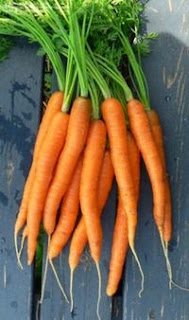Soil conditions for growing carrots
The ideal soil conditions to cultivate your carrots would be a light, sandy, well-drained earth with a slightly acidic pH balance of 6.5. Planting should start once the soil reaches a temperature of 65°F (18°C).
|
Climate conditions for growing carrots
To get the best results, carrots should be cultivated in a sunny spot that receives plenty of direct sunlight. The seedlings will be able to cope with some shade and even a small amount of light frost, yet lots of sunshine is always the best for this crop.
|
|
Soil preparation
The soil should be prepared approximately 2 weeks before you are due to plant the seeds. Dig an area of about 1ft (12 inches) deep and work the soil so that its texture is even, fine and crumbly. Remove all debris, particularly any stones, which can cause deformation of the carrot's shape, and work in some fully rotted organic matter, which will keep the soil loose and moist, perfect growing conditions for the carrot.
For early varieties planting will take place in mid-February and therefore you should prepare the soil at the beginning of the month, whilst maincrop varieties can be grown from late April. One week before planting you can add a general fertilizer, one that does not contain high levels of nitrogen, as this could cause the seeds to grow multiple roots. In most cases, plenty of compost or peat moss is enough for carrots to grow well. |
|
Planting the carrot seeds
Thinly plant the tiny carrot seeds in drills that are about ½ inch deep. Drop a few seeds into the soil at every inch. The rows should be approximately 8 inches (20cm) apart. Cover the seeds with fine soil and apply a very thin layer of straw or shredded bark. Germination takes place within 15 - 20 days.
|
|
Thinning the seedlings
The seedlings should be carefully thinned out when they have sprouted and reached a height of approximately 1 inch (2.5cm). Space them out so that they are first 2 inches (5cm) and then 5 inches (12cm) apart. Thin the seedlings at night, as this is when the carrot fly are absent, and destroy all trimmings by either burning, burying or binning them.
Ensure that the roots of the seedlings do not suffer too much disturbance, as this can affect their growth. Pat down the soil after thinning, as carrot fly like to lay their eggs in loose soil. Apply a layer of mulch about ¾ inch thick once the plants have been established. |
|
Watering the carrot seedlings
The soil should be kept moist at all times but carrot seedlings do not need to be deluged in water. Water when the soil is dry and keep the soil moist and the plants will be happy!
|
|
Fertilizing the carrot seedlings
Do not over-fertilize the carrot plants. Carrots do not need high levels of nitrogen to grow well and so use fertilizers that contain nitrogen sparingly. In most cases, the use of plenty well rotted organic material is enough.
|
|
Harvesting the carrots
Early crop varieties will be ready to harvest some time in June, whilst maincrop varieties can be harvested in August.
The carrots should be removed from the ground as soon as the foliage begins to shrivel up and wilt and when the carrot has turned a deep orange. Gently loosen the roots with a fork and then remove the vegetable by hand. Harvesting should be carried out at night, for the same reasons that thinning of the seedlings is done at this time of day. Store the newly dug carrots in a box that has a layer of sand on the bottom and place in a cool, dark and dry location. |
|
Carrot pests
The carrot fly is the main insect that can cause problems when cultivating this crop. It lays its eggs in any soil surrounding the base of the plant that is loose. The eggs turn into maggots, which then attack the plant and destroy it. Ensure that trimmings are disposed of and that soil around the plants is firm.
Companion Plants with Carrots Their pals are leaf lettuce, onions and tomatoes. Plant dill and parsnips away from carrots. Flax produces an oil that may protect root vegetables like carrots from some pests. One drawback with tomatoes and carrots: tomato plants can stunt the growth of your carrots but the carrots will still be of good flavor. |
Carrot disease
The carrot plant may be prone to a number of fungal diseases. Look out for signs of wilted or spotted leaves and any type of irregular markings. Too much water, sun or nitrogen will also affect the plants negatively.
I hope you have enjoyed another educational article. if you have additional questions, please leave a comment below or send an email to mary@marysheirloomseeds.com
Sign up for our E-Newsletter






1 comment
New to your site. Old in age, but always young at heart. Always open to learning. Your informational training tips are great!
Will try to follow to continue to get more successful in gardening.